Moonambel Heritage Walk

This is an easy short self-guided walk around the historic gold mining town of Moonambel starting in front of the school. It reveals the rich history of the old township's pioneering days from settlement in 1844 to the goldrush in 1860, and beyond.
Moonambel Heritage Walk Map
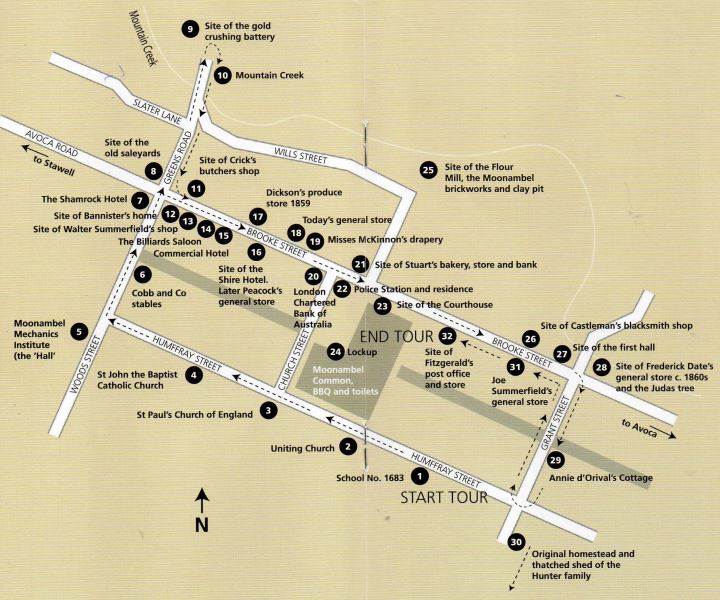
1. School No.1683
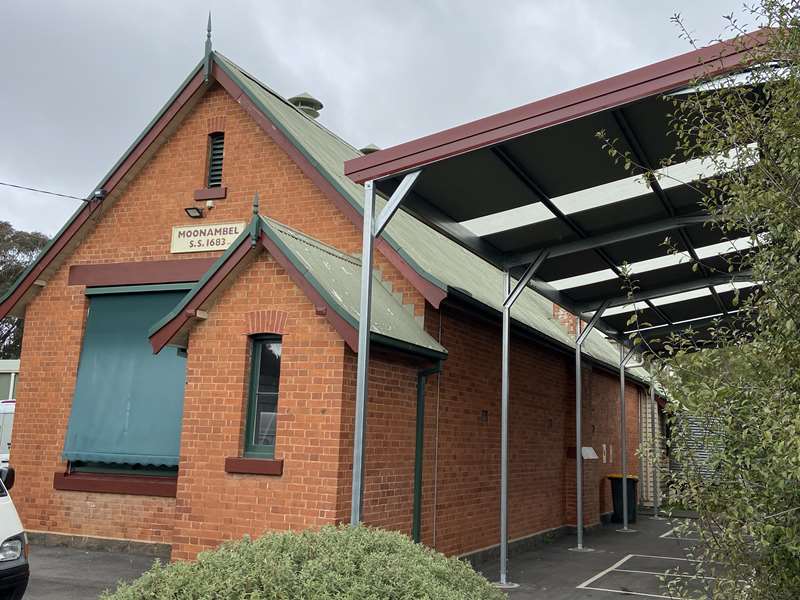
The first school was opened in January 1861, a mere two months after the discovery of gold, in a tin shed with a dirt floor leased from the Church of England. The current building opened in 1875. Erected by the Education Department, it is typical of school design of the era, its brick construction reflecting the prosperous future predicted for the township. Hard to believe that it accommodated between 60 and 100 children.
Turn left out of school gate.
2. Uniting Church
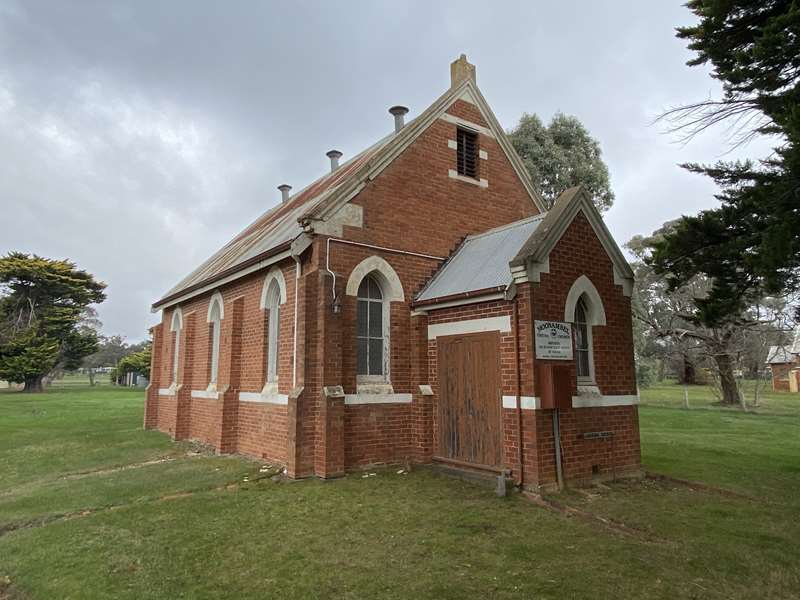
The original church was a galvanised iron structure transported by horse and dray from the Lamplough goldfields in 1856. Some sheets survive today on Keith Hunter's old woolshed. The current building, built in 1913, is typical of small rural churches built during this period, and demonstrates a continuation of the tradition of Methodism begun on the Moonambel Goldfields in 1861.
Continue down the road.
3. St Paul's Church of England
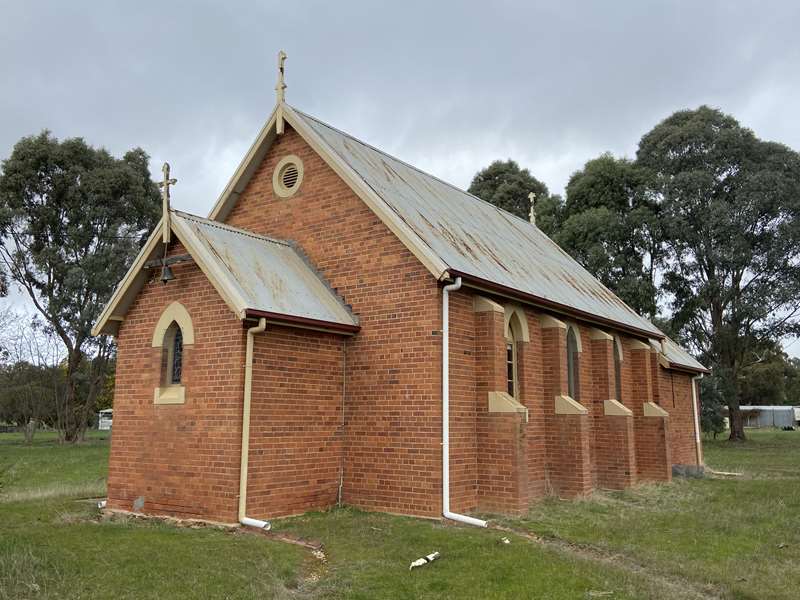
St Paul's, a brick church dating back to 1878 is the oldest surviving church in Moonambel. The first services were held in a tin shed with a dirt floor behind the current building.
Continue down the road.
4. St John the Baptist Catholic Church
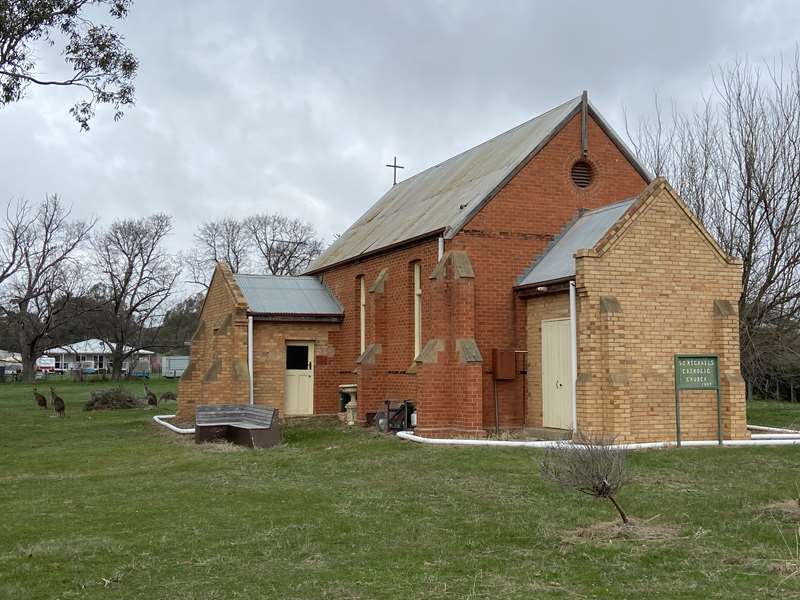
This brick church dating from 1884 is typical of small rural churches built during this period. Closed 1996.
Continue down road; note the building at the end of the road.
5. Moonambel Mechanics Institute (the 'Hall')

This was opened on 19th November 1937, after a flood washed away the first hall, (c.1901) in 1933. The occasion was marked by a Grand Ball with supper, dancing and musical items - including one by 'Tom Clifford from Bowenvale who danced a soft shoe shuffle dressed in top hat and tails'. The hall still gets used regularly and is run by a Committee of Management.
Turn right and walk towards the main road.
6. Cobb & Co stables
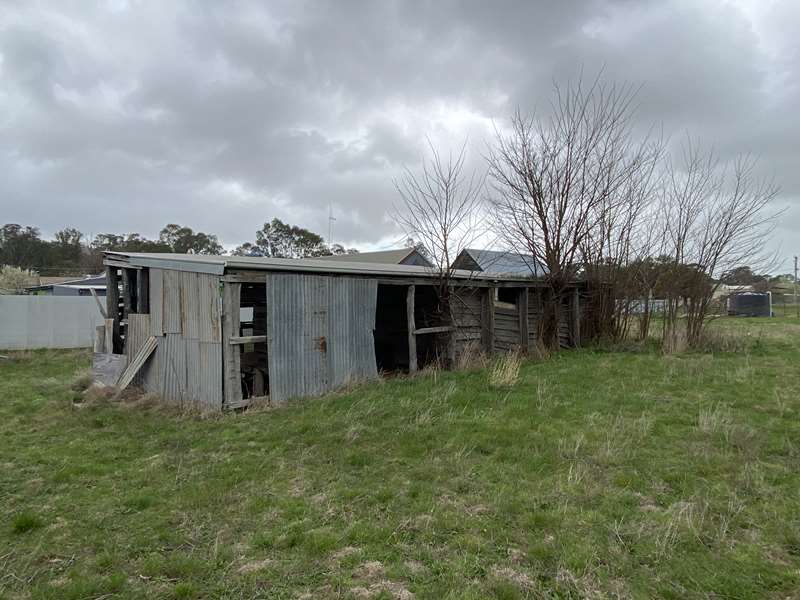
On the right, this shed at the back of the present hotel is the Cobb & Co stable used for overnight stabling of its horses on the regular coach service passing through to Adelaide. It was a six-horse stable. The stalls and the unique flooring of timber planks diagonally cross-patterned to prevent the horses slipping, are still in place. The external slab construction is quite visible today.
Continue on to the corner.
7. Shamrock Hotel
The Shamrock Hotel of 1861, 'A fine two-storey building' was situated here on the corner of Brooke & Woods Streets.
Cross the road.
8. Site of the old saleyards
The present house on the northwest corner sits on the site of the old saleyards. Butchers there were aplenty in the burgeoning township. In the 1860s, John Wills, a butcher to the miners, used offal to fertilise the river flats where his stock were fattened. Leaving piles of offal in the yard until rotten, he would shovel them into a cart, scatter a Capstan tobacco tin-full of red clover-seed over the offal and spread it over the river flats. Another first for Moonambel - an organic composter. The pastures proved verdant - as did, thought the neighbours, the stench!
Walk on down the dip to the creek at no. 10 and look left across the creek to the rise.
9. Site of the gold crushing battery
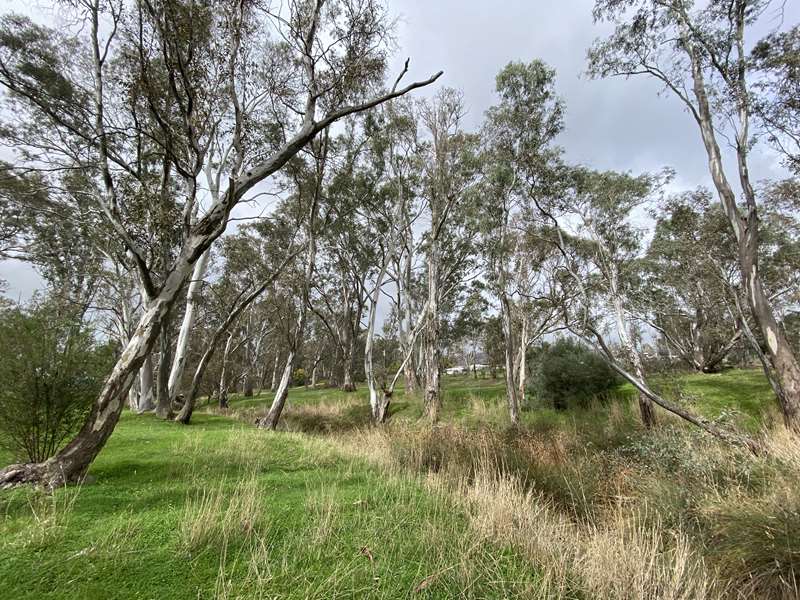
This was the site of one of three gold mining batteries in Moonambel. The formerly denuded landscape is now an attractive picnic ground. This is a lovely area with toilets, shelter with table, scattered tables and BBQs.
10. Mountain Creek

In 1852, on a mission to discover the most direct route between Adelaide and the Mount Alexander diggings for the South Australian gold escort, Alexander Tolmer described passing through a gap in the Pyrenees and camping the night in the valley beyond 'in the heart of the mountains'. Mountain Creek was the original name for the township of Moonambel, the Dja Dja Wurrung word for 'hollow in the hills'. The creek is still pitted along its length with mine shafts, mullock heaps and clay pits where clay was extracted to make the bricks used in many of Moonambel's original buildings.
Walk back to the main road corner for no.11.
11. Site of Crick's butchers shop
On this corner (conveniently adjacent to the saleyards!) was Crick's butchers shop. Perhaps fortunately (we might observe) it was not John Wills' butchery! (see above entry, site 8) McKenzie's was another of the town's butchers. Easy selection of the choicest cuts was an obvious bonus for McKenzie's customers!
Look across the road to the vacant block, nos 12, 13.
12. Site of Bannister's home
Arthur and Mary's Bannister's home stood on the corner. In its many guises the corner dwelling was once also Hudson's saddlery and a fruit depot for elderly Mr Sanderson the local grocer who 'peered through square lenses seemingly made from blue castor-oil-bottle glass'.
13. Site of Walter Summerfield's shop The Bannister home sat cheek-by-jowl with the Summerfield home and business - which is perhaps not surprising, as Walter's wife was Arthur Bannister's sister. An industrious man, Walter Summerfield pulled teeth, shod horses, made leather boots, bought gold, sold tobacco, made beautiful layered picture-frames out of cigar boxes and he was a shearer in his spare time. According to his grandson Ian Summerfield: 'He could turn his hand to anything!' Still clear in Ian's memory today is his own daily ritual of delivering a newspaper to his grandmother on his trike.
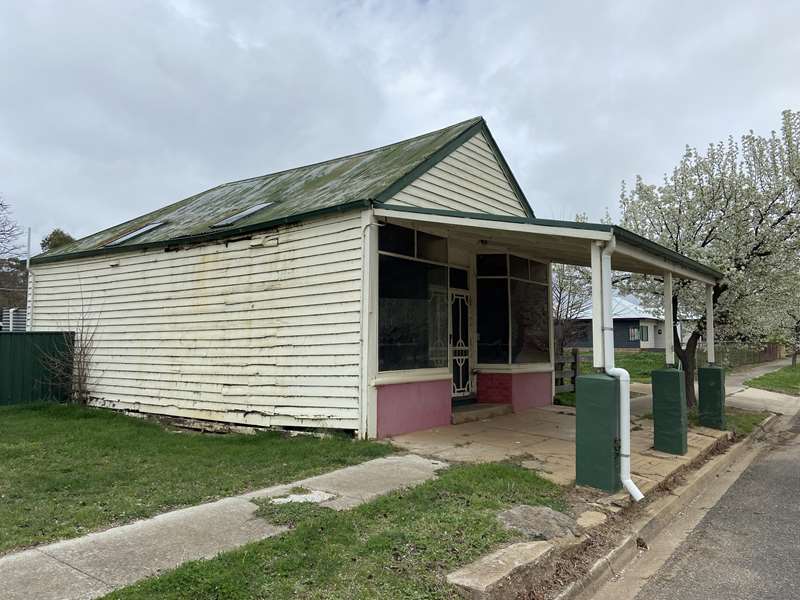
Walk on to the old brick store opposite the Moonambel Hotel, nos 14, 15, 16 & 17.
14. The Billiards Saloon
Across an alley, wedged between the timber cottages and abutting the grand edifice of the Commercial Hotel was a Billiards Saloon (see stepped gable roofline in photo). It still stands - now subsumed as an extension of today's hotel (see the middle gable of today's hotel).
15. Commercial Hotel
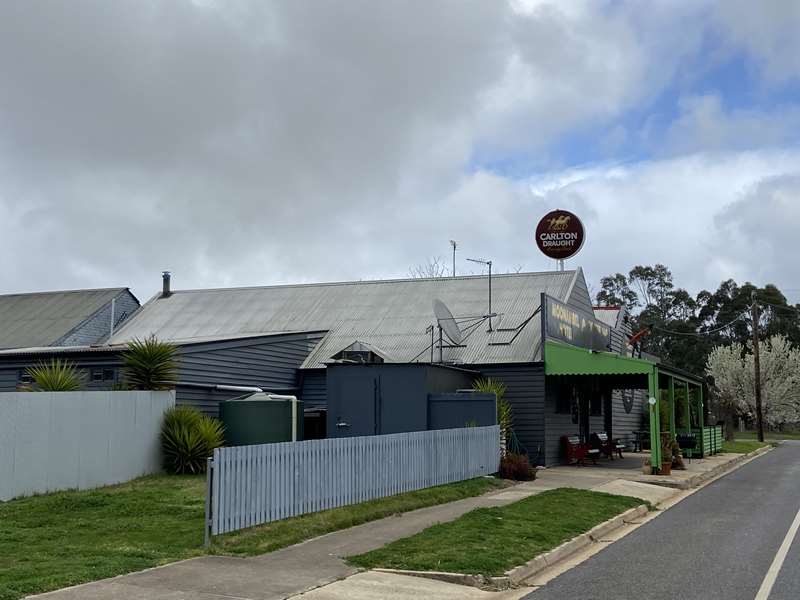
A timber structure, operating in 1861 during the gold rush when Moonambel had a population of over 30 000, it has operated continuously as a hotel since then and is one of the earliest surviving commercial buildings in the Moonambel township. It has been altered and extended over time, demonstrating the changing demands made upon a Public House over a period of 149 years. 'The first class hotel of the district' (according to the 1865 Government Gazette). Its colourful history includes time during the gold rush as a coach booking office, magistrate's court and the municipal shire office. It even boasts early feminist links in the persons of sisters Emily and Ada Moyle (b.1887/1888) who took it over in 1913 and ran it for 50 years. In 2009, following local colloquial usage, the venerable institution was renamed the Moonambel Hotel.
16. Site of the Shire Hotel/ later Peacock's general store
The Shire Hotel in its 'coat of many colours' was an intrinsic part of the town streetscape precinct in the 1860s, remaining so until the early 1970s. Located as it was between the Commercial Hotel and the bank, it capitalised on its central position and was a hive of social and business activity in the heady golden days for both the thirsty miners and the civic gentlemen. Later reincarnated as flats, the central brick section housed Peacock's general store, which was still operating in living memory. Mrs Peacock was Moonambel's famous daughter. She had been 'a lady of note', a singer known as the Pyrenees Nightingale who used to tour the colonies. Before its demolition in the 1970s, the old Shire Hotel had 'graced' the main street of Moonambel for over 100 years.
17. Dickson's produce store 1859
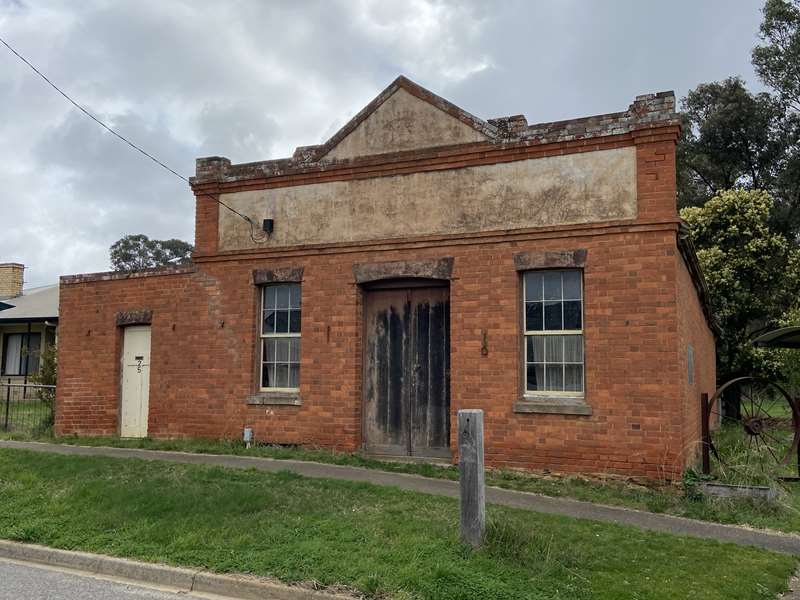
Dickson's solid brick construction and its prominent location abutting the main road characterises the very early growing township - the then substantial use of locally made bricks, the growing prosperity and the multiplicity of usage of buildings. The store has functioned over the years as a produce store, general store, saddlery, and in the 1860s housed the photographer, 'Snapshot' Moore, who ran his business from the small brick office at the front on the western side.
Continue on to today's general store.
18. Today's general store
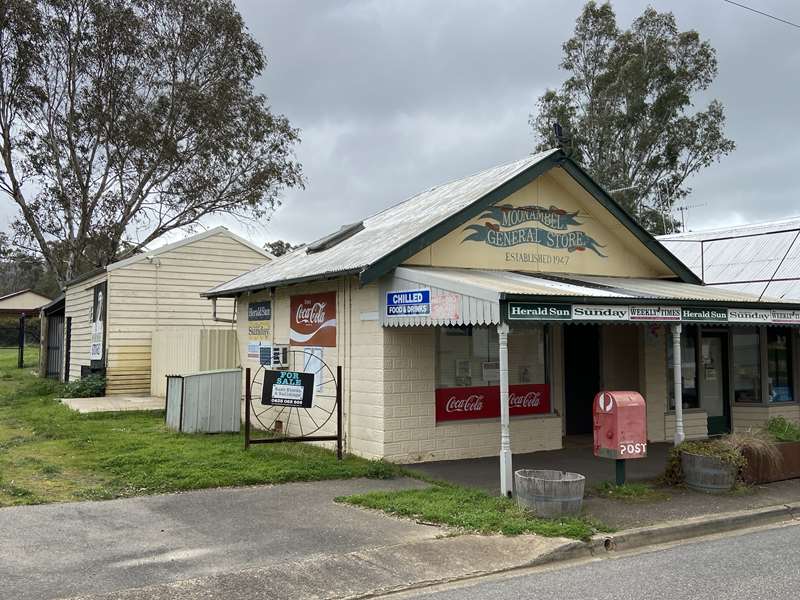
Most of today's store is a relative newcomer to the streetscape of the old town, dating to the early 1900s. But as elsewhere amongst the remains of Moonambel's disappearing past infrastructure, looks can be deceiving.
Walk to the far (eastern) end and look at the small room set back from the frontage (no. 19).
19. Misses McKinnon's millinery and drapery
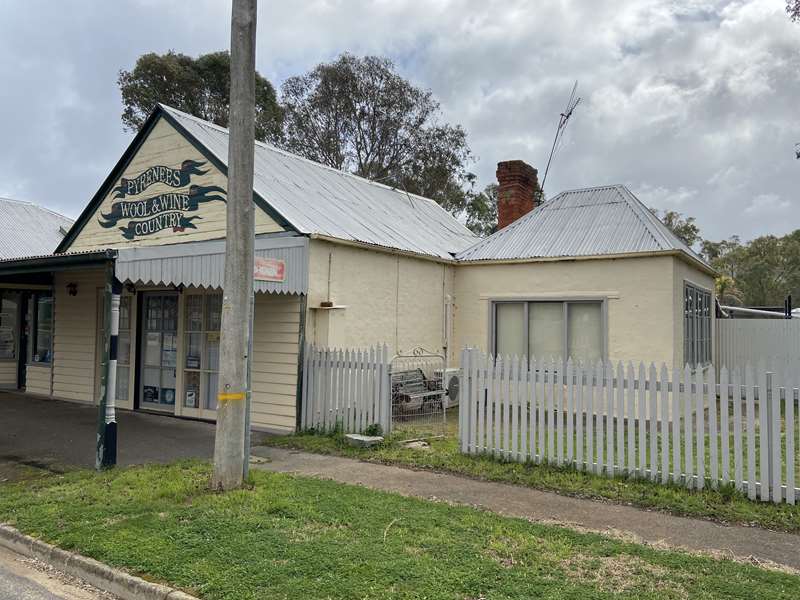
This mudbrick / rendered extension is the original 1800s Misses McKinnon's draper's establishment, which sold all drapery and millinery needs including top hats. According to the Advocate Mail of June 1865, on the night the Pilot Boat Hotel burnt to the ground on the opposite side of the street, 'the signboard of Misses McKinnon's drapers shop took fire but was torn down and the building saved, otherwise the fire must have proved most terrible in its effects - an adjoining store containing an unusually large stock of blasting powder and kerosene'.
Look across the road to the small red-roofed cottage adjacent to the lane, no. 20.
20. London Chartered Bank of Australia (later Delia's cottage) c.1860/61

The precise provenance of this building is still discussed. Old land title records indicate that this is the site of the brick London Chartered Bank of Australasia of 1861. The present timber cottage is one of two of the early 'toll gate' houses moved here subsequently and locally known as 'Delia's cottage' after the noteworthy pioneering woman, Cordelia Wright, who lived there from the 1940s. She was an extraordinary woman whose literary skills were passed on to her daughter Rita (1920-2008) the author of Moonambel Memories (2006).
Walk on to no. 21 on the next corner.
21. Site of Stuart's bakery, store and bank
The building on this site was built in 1873 and was in continuous use for almost eighty years before it closed. It was originally built as a National Bank, was fleetingly a police station, lockup and courthouse before becoming a bakery and grocery store. David Stuart, the proprietor, was also a gold-buyer and during the Depression, was also the Sustenance Officer dispensing food vouchers. A heritage sign is located in the Common. The vacant corner across the lane held stacks of firewood not only for the baker's oven but also for Moonambel's brickworks which were sited back across the creek. Sawdust and charcoal from the oven's fireboxes to this day provide fertile garden soil.
Stand at no. 21. Look across road towards nos 22, 23 & 24.
22. Police station and residence
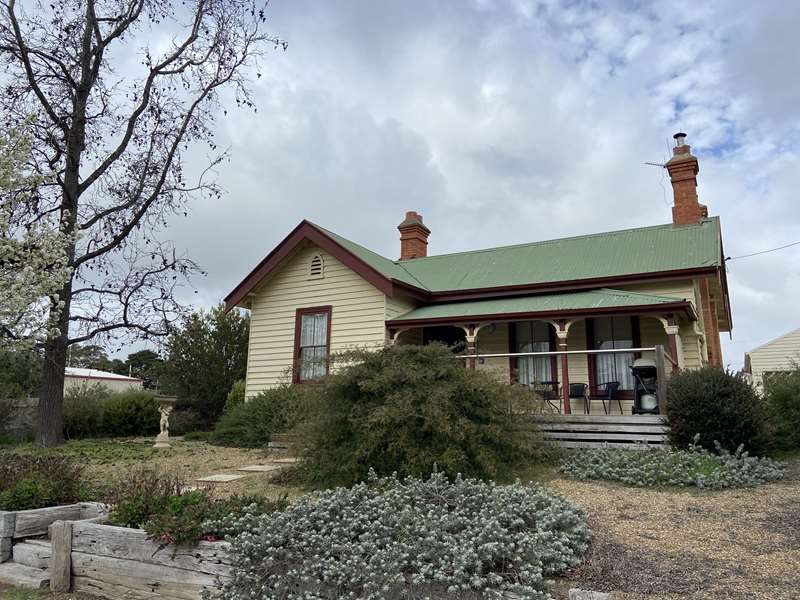
You are looking at the original police station and residence and the site of the courthouse in what was the Police Camp precinct (now the Moonambel Common). The design of the former police station and residence is characteristic of police buildings in the 1880s. Together, the lockup and the police station/residence are important material reminders of the role played by the police in enforcing law and order in the mining towns of the 19th Century.
23. Site of the Courthouse
By 1865, Moonambel had consolidated into a modest mining township and it still acted as the administrative centre for the surrounding locality with a Court of Petty Sessions and a Warden's Court. The Courthouse was built in 1881 adjacent to the police station. Cited as 'the most well-travelled courthouse in the State' it was moved in 1953 to Landsborough West for use as a hall and then to Stowell. Both the relocated courthouse and the original police station seen here are still in use as private homes.
24. Portable lockup

The portable lockup situated behind the police station is a timber construction dating from the 1860s and thought to be only one of three remaining. Loaded onto a dray and moved to the next gold rush on the Victorian goldfields, they are a reflection of the highly mobile nature of the gold mining population. It has architectural interest for its solid timber construction, with steel bars running through the walls, ceiling and floor. Offenders were mostly housed in the lockup overnight before coming in front of the magistrate. The most common offences were drunk and disorderly and vagrancy. The youngest to spend the night in gaol was a one-year-old.
Either walk across the main road and through the Common to view the lockup now or at the end of the tour which finishes here. Next: look left up to the end of the side street to the grassy space alongside the creek.
25. Site of the Flour Mill, the Moonambel brickworks and clay pit
In 1868, incredibly, an imposing three-storey brick flour mill, constructed out of Moonambel bricks, stood here on the banks of the Mountain Creek. It was owned by the eminent John Dickson, a 'solid' citizen and businessman of the fledgling township. An emigrant born near Glasgow in 1827, 'the big man' cut quite a figure in town affairs including the position of Mayor when Council used to meet in the Commercial Hotel. He died in 1874. Like most of Moonambel's gold-era infrastructure, even substantial brick buildings such as this, the flour mill was later pulled down and carted away.
Continue on along the verge towards the next corner.
26. Site of Castleman's blacksmith shop
Regrettably little photographic record remains; but the current owners whilst digging fencepost holes found much evidence of old nails, horseshoes etc.
Stand on the corner for nos 26 & 27.
27. Site the first hall
Built in 1901 the township's hall was washed away in the great flood of December 1933. Several of today's old residents remember the flood well and recount that parts of the hall were found miles away. The piano too took to the waters and floated gaily away, reputedly tinkling the ivories as it did so.
Cross the lane, no. 28.
28. Site of the Judas tree and Frederick Date's general store c.1860s
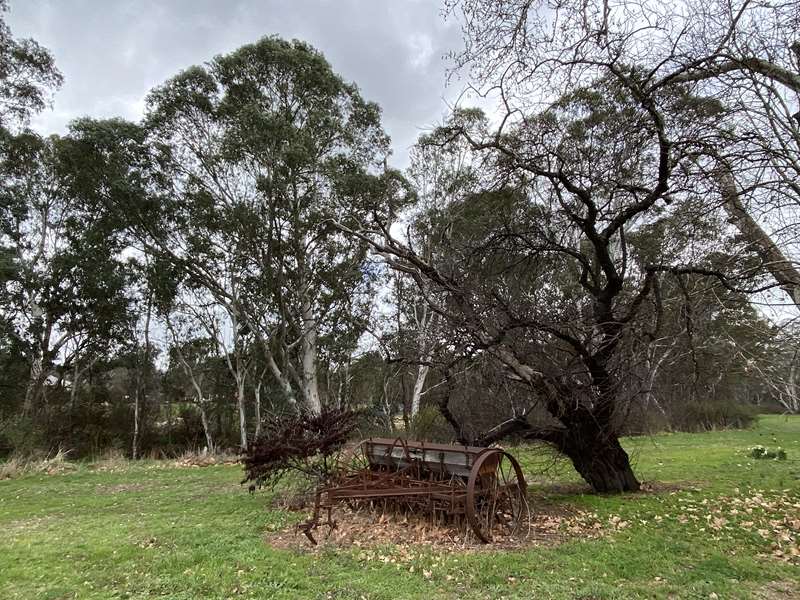
Alongside the site of Dates store, and still growing, is an iconic part of the Moonambel collective memory - the Judas tree. This small wiry tree is thought to have been planted by Malvina Richardson who brought the seed from America to Australia when she migrated in 1854.There are a number of specimens growing in the township but this has strong symbolic significance for her descendants, who still meet for family reunions. A remarkable woman for her times, Malvina Richardson was born c.1824, part Red Indian, part Spanish, part English; married three times (all husbands deceased her); had eight children; and even before migrating from the American gold fields to the Australian diggings in 1855 with her then third husband, had survived the 2000-mile wagon-train trail crossing the American West. They followed the gold to the McKinnnon diggings (Moonambel) in 1861, and after the death of her third husband seven years later, Malvina continued working as the district's midwife until her death in 1909. The tree, possibly the first Judas tree planted in Australia, continues to provide a brilliant display of pink flowers in spring.
Cross-over the main road and walk to no. 29.
29. Annie D'Orival's Cottage
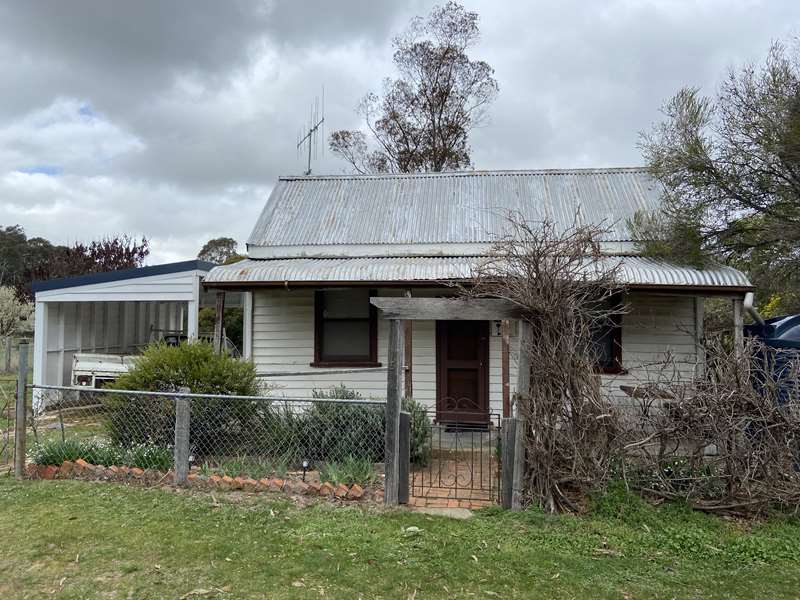
This is where Mrs Annie D'Orival (c.1886-1956) lived. Coming to live in Moonambel in 1901 from her birthplace at Barkly, she became the sewing mistress at the school in 1907 and held that post for 27 years even after her marriage, which was unheard of in those days. Annie is a fondly remembered local figure and another of the town's remarkable early women pioneers.
Walk a little further on to the crossroad and look south across the open paddock to nos 30 & 31.
30. Original homestead and thatched shed of the Hunter family
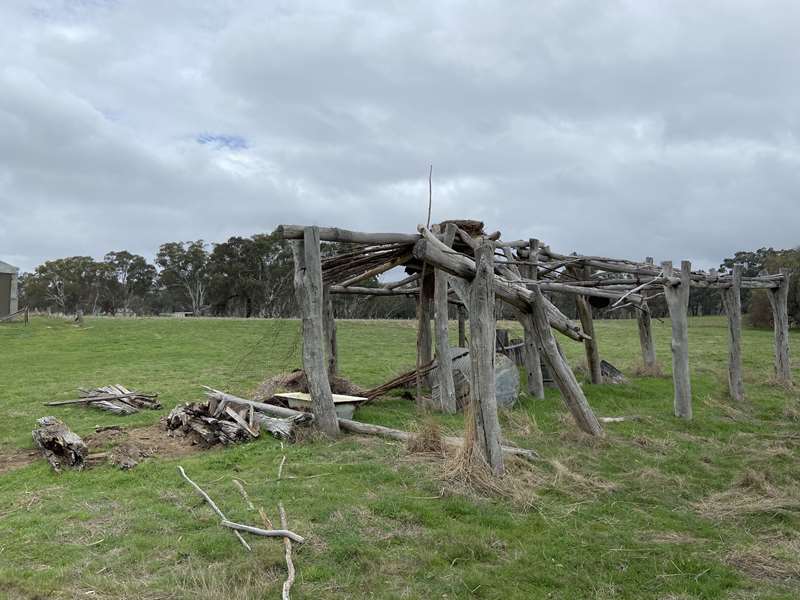
James and Helen Hunter who arrived in the colony in 1849 and moved to Moonambel in 1860 built this homestead in c.1860. Several members of the pioneering Hunter family still live and farm here. Another of their great grandfathers, John Murgatroyd, was a well-known figure in the early days as the owner of the Yankee Soap and Candle Factory. He travelled up to 100 miles a month selling his wares including his 'magic soap' which, as was the then practice, was mixed with the shearer's urine to pre-wash the sheep before shearing. The thatched shed by the road is Hunter's original shearing shed.
Walk back to the main street and return towards the town.
31. Joe Summerfield's general store
In 1926, Joe Summerfield purchased Fitzgerald's business (but not the post office agency), built the current shop and opened a general store delivering bread and groceries to the residents. Sons Russell (deceased) and Ian (of Summerfield Wines) lived and worked here until into their twenties. The shed next door garaged Joe's prized first new delivery-van bought that year. The store has another lease of life now, operating as a wine depot.
Walk back on the footpath towards the Common.
32. Site of Fitzgerald's post office & store
This building, an early part of the streetscape, still housed a business in the 1970s - namely the town's post office. In 1977, the post office agency changed hands and moved into 'modern premises' further up across the street. Subsequently, the original building was moved over to the other side of the creek and, although much altered over time, is still used as a residence today.
This is the end of the tour.
Information compiled by Jill Hunter and Noreen McAdam.
Note: A printed version of this guide is available from the Avoca & Pyrenees Visitor Information Centre in Avoca for a gold coin donation.
Photos:
Location
24 Humffray Street, Moonambel 3478 View Map









